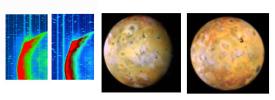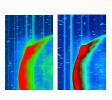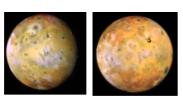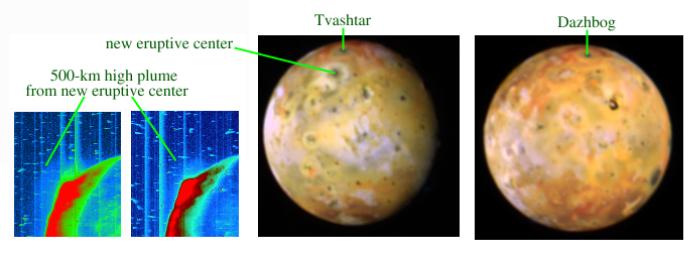Backlit views (left pair) show a giant volcanic plume as a bulge on the crescent edge of Jupiter's moon Io, and more fully lit views (right pair) reveal rings where sulfur-rich plume material has fallen back to the ground, in images captured by NASA's Galileo spacecraft in early August 2001.
Io is the most volcanically active world known. Galileo and NASA's Voyager and Cassini spacecraft have caught several of Io's volcanoes in action lofting plumes of gas and particles high above the large moon's surface. However, none of the plumes seen previously has climbed as high as the one evidenced in three of these pictures.
During its Aug. 6, 2001, close encounter with Io, Galileo flew right through a space where a plume from the Tvashtar volcano near Io's north pole had been active when Galileo and Saturn-bound Cassini imaged Io seven months earlier. To see if the Tvashtar plume was still active in August, scientists used Galileo's camera to acquire images when the spacecraft was nearly on the opposite side of Io from the Sun, so that Io appears as a backlit crescent.
Tvashtar's plume did not show up, but another one did, rising from a previously undiscovered and still unnamed volcano about 600 kilometers (370 miles) south of Tvashtar. The left two images are color coded to reveal the faint outer plume. The bright inner plume rises about 150 kilometers (90 miles) high, and the top of the faint outer plume can be detected at 500 kilometers (310 miles) above the surface, making this is the largest plume ever detected on Io. A portion of the plume with intermediate brightness extends north of the eruption's source vent. (The vertical lines, bright spots and short streaks in these two images are noise.)
One of the more fully illuminated color images of Io (second image from right) reveals a bull's-eye ring of new dark and light materials marking the eruption site. No obvious volcanic center had previously been seen at this location, 41 degrees north latitude and 133 degrees west longitude. The bright material of the new plume deposit overlies the red-ring plume deposit encircling the Tvashtar volcano at 63 degrees north, 123 degrees west. Tvashtar's ring deposit was first seen in Galileo images taken in late December 2000.
Another new full-disc color image of Io (far right) reveals yet another new plume deposit near Io's north pole, encircling the Dazhbog Patera volcanic site. This red ring has a diameter of about 1,000 kilometers (620 miles), suggesting a plume height of about 300 kilometers (190 miles). This plume deposit was not present in January 2001, so it is evidence of a new eruption.
Io is about the same size as Earth's Moon. All four images have resolutions of 18 to 20 kilometers (11 to 12 miles) per picture element. Unlabeled versions are also available. Click on the thumbnail versions below.



Infrared imagery from Galileo or Earth-based telescopes has detected intense hot spots at the sites of all three of these giant plumes. Giant polar plumes represent a class of eruption seen by the Voyager spacecraft in 1979, but not during Galileo's first five years of orbiting Jupiter. Voyager was unable to measure temperatures or other properties of these eruptions, so scientists are pleased Galileo has survived long enough to do so. Galileo reached Jupiter in late 1995. Its original two-year orbital mission has been extended three times to take advantage of the spacecraft's continuing capability to return valuable scientific information about the Jupiter system.
The Jet Propulsion Laboratory, a division of the California Institute of Technology in Pasadena, manages the Galileo mission for NASA's Office of Space Science, Washington, D.C. Additional information about Galileo and its discoveries is available on the Galileo mission home page at http://solarsystem.nasa.gov/galileo/.

 Planetary Data System
Planetary Data System















